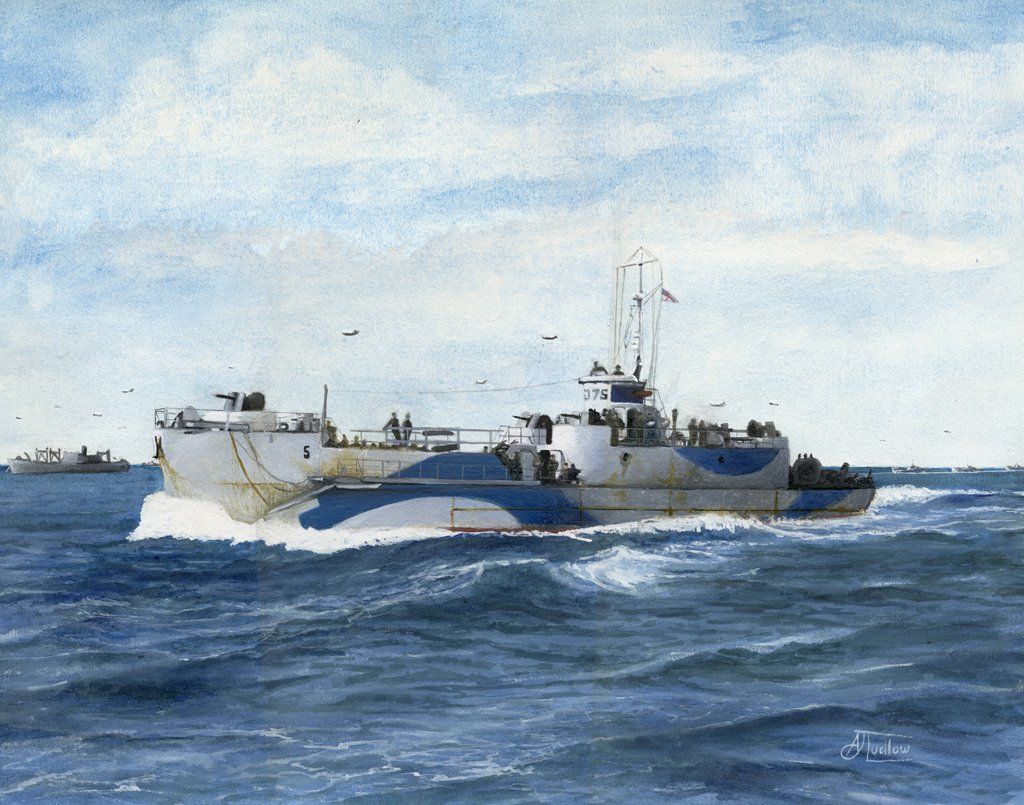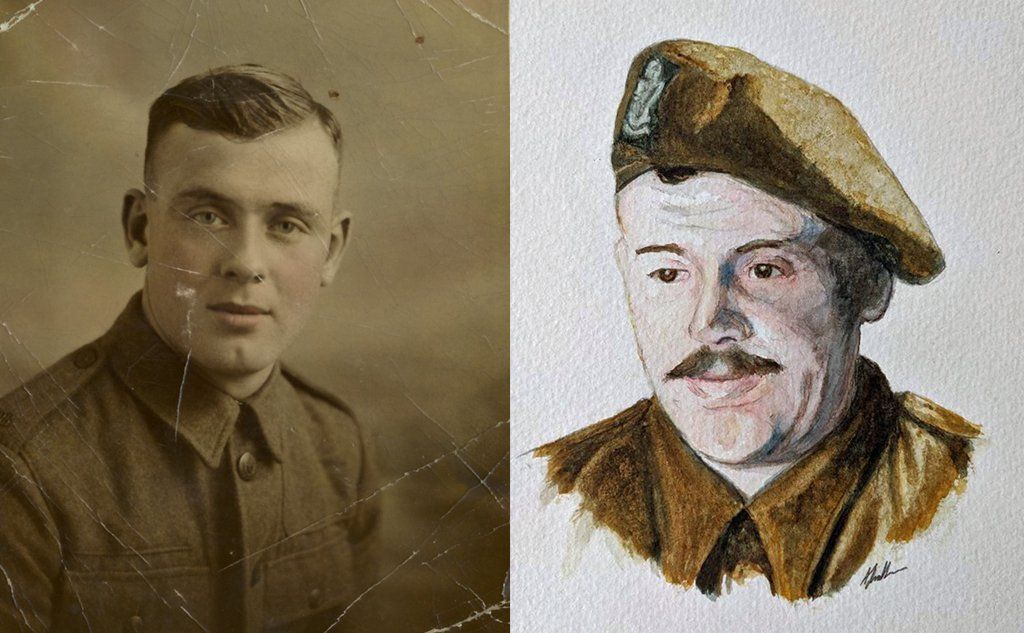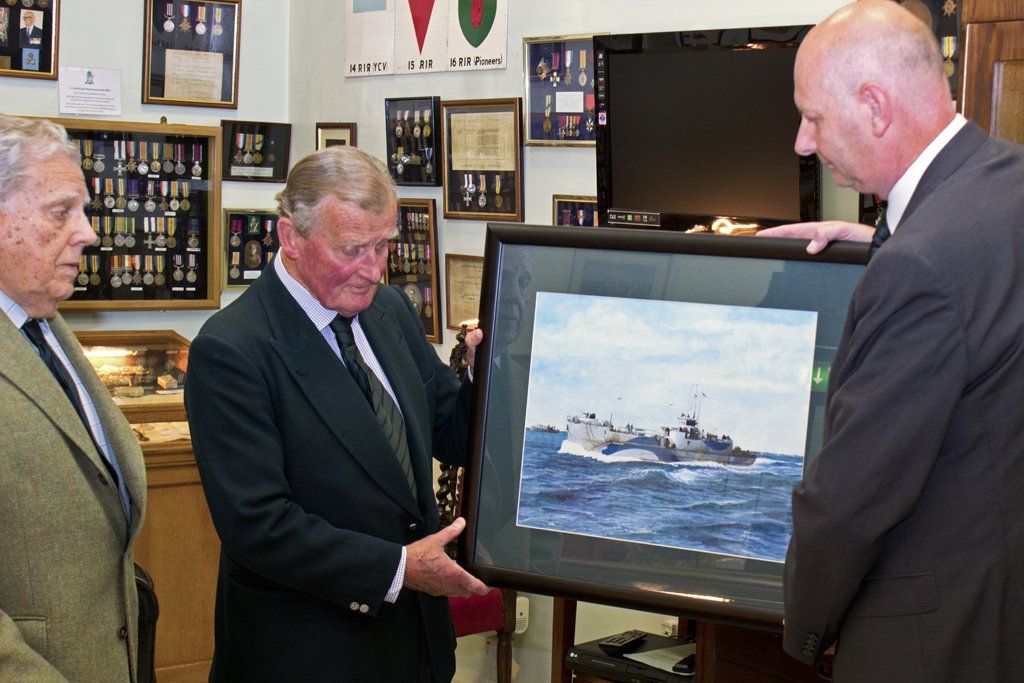ARTicles
The Painting of “Landing Craft Infantry 375” and the Story Behind it.
There is an old saying that “every picture tells a story”

This is the story of one of my paintings, “Landing Craft Infantry 375”, which depicts a Royal Navy landing craft racing to Sword Beach early on the morning of 6th June, 1944. To me this landing craft was something special as it introduced me to some very interesting and brave individuals, gave me the opportunity to discover its story and challenged me to learn more about Landing Craft Infantry (LCI) 375 and the morning of D-Day, so that I could convert black and white imagery, into glorious and life-like colour.
Landing Craft Infantry 375
On the morning of the 6th June 1944, LCI 375 was taking a company of the 2nd Battalion of the Royal Ulster Rifles (RUR) to the Normandy coast. It hit an obstacle just off the beach and so whilst the riflemen were disembarking, the craft was taking on water. Subsequently, the crew had to abandon ship and the craft became beached near Lion-sur-Mer as the tide went out. During the day, fire was returned from its forward gun turret on the enemy and a temporary repair of the holes in the hull was made using concrete and clamps in order to allow the craft to get back to the UK for a permanent repair (White, 29/06/2004). During the following weeks and months LCI 375 and its crew ferried Allied troops to the Normandy coast and returned with German Prisoners of War and thus fulfilled its role in Operation Neptune.
Figure 1: Landing Craft Infantry 375 on its way to the Normandy Coast and Alfred White, RN.
On board that day was the ship’s electrician, Alfred White, a Belfast man who on 6th October, 2009, walked into the RUR Museum in Belfast, presented them with a photograph of LCI 375 and then told the curator his story, which is where my story begins.
The Royal Ulster Rifles and family ties
My family has had a long association with the Royal Ulster Rifles; my grandfather served with them from his enlistment in 1933, through to his de-mobilisation just after World War 2. Born in Carrickfergus, Northern Ireland and with little prospects of meaningful work, he enlisted into the 2nd Battalion and met my grandmother during his first posting to Gravesend in Kent. After the war, he returned to Gravesend and made it his home, along with many other Riflemen who had met and married local girls during their pre-war posting. In the post war years, he was very active in the Gravesend Branch of the Regimental Association until his death at 57 in 1972.
Figure 2: My grandfather, Rifleman John McMillan, on enlisting and from a watercolour portrait (“Rifleman John (Jack) McMillan, 2RUR” by Andrew Ludlow) from a photograph taken around 1944.
It is therefore no surprise that from an early age, I became interested in my grandfather’s exploits and the regiment he was so proud to be a part of. Unfortunately, he passed away during my early teens and so I was unable to hear his stories from the man himself, so I took to researching the regiment’s history, which in turn led me to the Royal Ulster Rifles Museum at 5 Waring Street, Belfast. It was here that I met Terrance Nelson and Isaac Hall and heard Alfred White’s story. The thought that maybe LCI 375 had carried my grandfather to the Normandy beaches, began to take shape, as did the desire to paint LCI 375 and to have it on display in the Museum.
I wrote to Alfred White in May 2010 and asked for his permission to use his black and white photograph as the basis of my painting. After a year’s delay due to illness, he replied, agreeing to my request and so I started work.
The Painting
I deciding to paint the work in both transparent and opaque watercolours. This was before I made my own colours, but I was very mindful to use the best quality available at the time. I also used a robust watercolour paper that was made from 100% cotton fibre, which allow me to achieve the results I was looking for.
After drawing out LCI 375, I painted the sky first, which from coloured photographs (“Victory in Europe”, page 14-15) showed the sky to be blue with the hint of clouds. I painted the sky in one go, with a wash of cobalt blue watercolour, blotting out the clouds with a dry tissue whilst the wash was still damp.
The sea during the early morning crossing on 6th June is shown to be very blue from the same contemporary photographs, thus reflecting the bright morning sky. Waves are very translucent and so in order to capture the movement of the sea, I used layers of transparent watercolour; making sure each layer was fully dry before adding the next. The wave’s shadow was created with Payne’s grey, whilst layers of ultramarine blue was used to create the sea’s flow as the waves form and are pushed away from the bow of the LCI (figure 3a). Finally, after adding fine lines of white gouache to create the tendrils of foam at the water’s surface, I gave the sea a wash of phthalo green (figure 3b), avoiding areas where the foam was at its whitest where I had left the paper blank.
Figure 3: Progressing the painting, working on the sea and Landing Craft, in order to give the waves translucence, but the ship solidity.
Scanning the photograph into my computer allowed me to zoom in to ascertain details on the ship’s deck. So, avoiding too much detail, I was able to hint at the figures on deck and paint them “accurately”, but in a way that they blend realistically into the painting. I also found using Alfred’s black and white photograph very beneficial because it is easier to see the tonal aspect of the picture, which can be quite difficult with a full colour image. But it was still difficult to see the detail of the LCI 375, especially in the area of the stern. I therefore needed to acquire more detailed material (“Landing Craft, Infantry and Fire Support”) to elucidate the structure at the rear, which turned out to be life rafts on their sides. The camouflage and the colour of the bridge, which is indicated in the photograph, was a fairly standard Royal Navy colour scheme, however when I looked through the resources I had gathered, the bridge could be either red or blue. As you can see in figure 3, I opted for red.
I sent Alfred a copy of the progress I had made on the painting, which he said was looking good, but he added that he did not remember the bridge being red, so I had to change it blue, which he said seem right. The LCI itself was painted with mainly white gouache tinted with watercolour, likewise the other ships in the background are also painted this way. Addition of fine lines of raw sienna and transparent iron oxide red watercolours, helped to define the hull’s structure and to give it that weathered rusty look, again the marks made on the hull by the anchor chain and rust trails can be seen in the photograph.
Presenting the Finished Painting
When the painting was finished and framed, I took it to show Alfred at his home on 23rd August 2013. It had been over 3 years, since first writing to Alfred and I was pleased with the result. During my visit he told me that when the photograph had been taken, he had been standing on deck holding the ship’s cat. He pointed at the figure in the painting that I though was holding a white rag and then told me the cat was white (figure 4). It was the first time I had met Alfred, but subsequently I discovered he was always very humorous and liked to tell a joke, so I am still not sure if he was pulling my leg about the cat or not!
Figure 4: Detail, showing the figure holding a “white cat”
The following year, my wife and I went over to Normandy with Alfred and his son-in-law for the 70th Anniversary Celebrations of D-Day. We all took part in the many Royal Ulster Rifles Association events at the Memorial Garden at Caen, Cambes-en-Plaine and Longueval and had tickets to see the amazing show on the beach, which had been Sword 70 years previously. For my wife and I, it was a trip of a lifetime and a chance to meet so many veterans like Alfred, that on the 6th June 1944, just by doing the job they had been given, had made a difference to the lives of so many.
Figure 5: Alfred White and painting
I remained in contact with Alfred, visiting him on a number of occasions until his death at the grand age of 93 on 13th September 2017 and was extremely proud to have known him and been his friend.
The painting was destined to hang in the RUR Museum in Belfast, where it hangs to this day and so was presented by myself to the Trustees of the Museum on 5th September 2013. It was here that I met Major-General Corran Purdon and Colonel Robin Charley, who accepted the painting on behalf of the Trustees of the RUR Museum. Both had been very active in the Regiment throughout most of their army careers; Major-General Purdon was commissioned into the RUR in 1939, but whilst attached to No 12 Commando had taken part in the raid on St Nazaire, for which he had been awarded the Military Cross and was captured and imprisoned in Colditz Castle* (website of the Royal Irish Regiment, accessed on 30/09/21). He later commanded 1RUR in 1962 during the battalion’s deployment to Borneo and their role in the Indonesia-Malaysia confrontation. Colonel Charley had enlisted into the RUR in 1943, serving in Europe and was a veteran of the Korean War, taking part in the Battle of Happy Valley, where 150 riflemen were killed or taken prisoner (website of the Belfast Telegraph, accessed on 30/09/21).
















